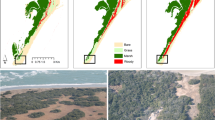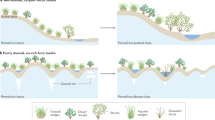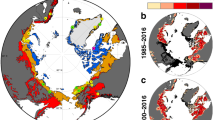Abstract
Harsh winters are a characteristic element of Arctic ecosystems, yet the importance of winter conditions for Arctic plant communities is still underrepresented in climate change impact studies. Here, we use fine-scale microclimate data with plot-scale records of vascular plants, lichens and bryophytes from three Arctic areas, and show that topographically heterogeneous tundra holds marked spatial variation, especially in winter temperatures. Winter conditions are the strongest environmental variable related to the fine-scale patterns in tundra vegetation, whereas summer temperatures mainly explain the coarse-scale differences among the Arctic areas. Nonetheless, the three plant groups (and also individual species) show often contrasting and complex responses along the local environmental gradients. Our results highlight the importance of local conditions and heterogeneity for tundra plants, and knowing that the Arctic winters are warming faster than summers, a greater focus should be placed on winter conditions in simulations of climate change impacts in tundra ecosystems.
This is a preview of subscription content, access via your institution
Access options
Access Nature and 54 other Nature Portfolio journals
Get Nature+, our best-value online-access subscription
$29.99 / 30 days
cancel any time
Subscribe to this journal
Receive 12 print issues and online access
$209.00 per year
only $17.42 per issue
Buy this article
- Purchase on Springer Link
- Instant access to full article PDF
Prices may be subject to local taxes which are calculated during checkout




Similar content being viewed by others
Data availability
The data that support the findings of this study have been deposited in a Zenodo public data repository (https://doi.org/10.5281/zenodo.3946817).
Code availability
The main computer code that supports the findings of this study has been deposited in a Zenodo public data repository (https://doi.org/10.5281/zenodo.3946817).
References
Natali, S. M. et al. Large loss of CO2 in winter observed across the northern permafrost region. Nat. Clim. Change 9, 852–857 (2019).
Myers-Smith, I. H. et al. Shrub expansion in tundra ecosystems: dynamics, impacts and research priorities. Environ. Res. Lett. 6, 15 (2011).
Elmendorf, S. C. et al. Plot-scale evidence of tundra vegetation change and links to recent summer warming. Nat. Clim. Change 2, 453–457 (2012).
Bjorkman, A. D. et al. Plant functional trait change across a warming tundra biome. Nature 562, 57–62 (2018).
Niittynen, P., Heikkinen, R. K. & Luoto, M. Snow cover is a neglected driver of Arctic biodiversity loss. Nat. Clim. Change 8, 997–1001 (2018).
Snow, Water, Ice and Permafrost in the Arctic (SWIPA) 2017 (Arctic Monitoring and Assessment Programme (AMAP), 2017).
Box, J. E. et al. Key indicators of Arctic climate change: 1971–2017. Environ. Res. Lett. 14, 045010 (2019).
Bintanja, R. & Andry, O. Towards a rain-dominated Arctic. Nat. Clim. Change 7, 263–267 (2017).
Post, E. et al. Ecological dynamics across the Arctic associated with recent climate change. Science 325, 1355–1358 (2009).
Blok, D. et al. The response of Arctic vegetation to the summer climate: relation between shrub cover, NDVI, surface albedo and temperature. Environ. Res. Lett. 6, 9 (2011).
Cooper, E. J. Warmer shorter winters disrupt Arctic terrestrial ecosystems. Annu. Rev. Ecol. Evol. Syst. 45, 271–295 (2014).
Sanders-DeMott, R. & Templer, P. H. What about winter? Integrating the missing season into climate change experiments in seasonally snow covered ecosystems. Methods Ecol. Evol. 8, 1183–1191 (2017).
Bokhorst, S., Bjerke, J. W., Tommervik, H., Preece, C. & Phoenix, G. K. Ecosystem response to climatic change: the importance of the cold season. Ambio 41, 246–255 (2012).
Williams, C. M., Henry, H. A. L. & Sinclair, B. J. Cold truths: how winter drives responses of terrestrial organisms to climate change. Biol. Rev. 90, 214–235 (2015).
Wipf, S., Stoeckli, V. & Bebi, P. Winter climate change in alpine tundra: plant responses to changes in snow depth and snowmelt timing. Climatic Change 94, 105–121 (2009).
Bokhorst, S. F., Bjerke, J. W., Tommervik, H., Callaghan, T. V. & Phoenix, G. K. Winter warming events damage sub-Arctic vegetation: consistent evidence from an experimental manipulation and a natural event. J. Ecol. 97, 1408–1415 (2009).
Rapacz, M. et al. Overwintering of herbaceous plants in a changing climate: still more questions than answers. Plant Sci. 225, 34–44 (2014).
Loffler, J. & Pape, R. Thermal niche predictors of alpine plant species. Ecology 101, e02891 (2020).
Choler, P. Winter soil temperature dependence of alpine plant distribution: implications for anticipating vegetation changes under a warming climate. Perspect. Plant Ecol. Evol. Syst. 30, 6–15 (2018).
Billings, W. D. & Mooney, H. A. Ecology of Arctic and alpine plants. Biol. Rev. Camb. Phil. Soc. 43, 481–529 (1968).
Cornelissen, J. H. C. & Makoto, K. Winter climate change, plant traits and nutrient and carbon cycling in cold biomes. Ecol. Res. 29, 517–527 (2014).
Groffman, P. M. et al. Colder soils in a warmer world: a snow manipulation study in a northern hardwood forest ecosystem. Biogeochemistry 56, 135–150 (2001).
Deems, J. S., Fassnacht, S. R. & Elder, K. J. Interannual consistency in fractal snow depth patterns at two Colorado mountain sites. J. Hydrometeorol. 9, 977–988 (2008).
Wahren, C. H. A., Walker, M. D. & Bret-Harte, M. S. Vegetation responses in Alaskan Arctic tundra after 8 years of a summer warming and winter snow manipulation experiment. Glob. Change Biol. 11, 537–552 (2005).
Darrouzet-Nardi, A. et al. Limited effects of early snowmelt on plants, decomposers, and soil nutrients in Arctic tundra soils. Ecol. Evol. 9, 1820–1844 (2019).
Nobrega, S. & Grogan, P. Deeper snow enhances winter respiration from both plant-associated and bulk soil carbon pools in birch hummock tundra. Ecosystems 10, 419–431 (2007).
Niittynen, P. & Luoto, M. The importance of snow in species distribution models of Arctic vegetation. Ecography 41, 1024–1037 (2018).
Blankinship, J. C., Meadows, M. W., Lucas, R. G. & Hart, S. C. Snowmelt timing alters shallow but not deep soil moisture in the Sierra Nevada. Water Resour. Res. 50, 1448–1456 (2014).
Kranner, I., Beckett, R., Hochman, A. & Nash, T. H. Desiccation-tolerance in lichens: a review. Bryologist 111, 576–593 (2008).
Cornelissen, J. H. C., Lang, S. I., Soudzilovskaia, N. A. & During, H. J. Comparative cryptogam ecology: a review of bryophyte and lichen traits that drive biogeochemistry. Ann. Bot. 99, 987–1001 (2007).
Sonesson, M. & Callaghan, T. V. Strategies of survival in plants of the Fennoscandian tundra. Arctic 44, 95–105 (1991).
Bjerke, J. W. et al. Contrasting sensitivity to extreme winter warming events of dominant sub-Arctic heathland bryophyte and lichen species. J. Ecol. 99, 1481–1488 (2011).
Pannewitz, S., Schlensog, M., Green, T. G. A., Sancho, L. G. & Schroeter, B. Are lichens active under snow in continental Antarctica? Oecologia 135, 30–38 (2003).
Natali, S. M., Schuur, E. A. G. & Rubin, R. L. Increased plant productivity in Alaskan tundra as a result of experimental warming of soil and permafrost. J. Ecol. 100, 488–498 (2012).
Weijers, S., Buchwal, A., Blok, D., Loffler, J. & Elberling, B. High Arctic summer warming tracked by increased Cassiope tetragona growth in the world’s northernmost polar desert. Glob. Change Biol. 23, 5006–5020 (2017).
Morris, W. F. et al. Longevity can buffer plant and animal populations against changing climatic variability. Ecology 89, 19–25 (2008).
Strimbeck, G. R., Schaberg, P. G., Fossdal, C. G., Schroder, W. P. & Kjellsen, T. D. Extreme low temperature tolerance in woody plants. Front. Plant Sci. 6, 15 (2015).
Gonzalez, V. T. et al. High resistance to climatic variability in a dominant tundra shrub species. PeerJ 7, e6967 (2019).
Thomas, H. J. D. et al. Traditional plant functional groups explain variation in economic but not size-related traits across the tundra biome. Glob. Ecol. Biogeogr. 28, 78–95 (2019).
Shipley, B., Lechowicz, M. J., Wright, I. & Reich, P. B. Fundamental trade-offs generating the worldwide leaf economics spectrum. Ecology 87, 535–541 (2006).
Good, M., Morgan, J. W., Venn, S. & Green, P. Timing of snowmelt affects species composition via plant strategy filtering. Basic Appl. Ecol. 35, 54–62 (2019).
Cornelissen, J. H. C. et al. Global change and Arctic ecosystems: is lichen decline a function of increases in vascular plant biomass? J. Ecol. 89, 984–994 (2001).
Zhu, L. K., Ives, A. R., Zhang, C., Guo, Y. Y. & Radeloff, V. C. Climate change causes functionally colder winters for snow cover-dependent organisms. Nat. Clim. Change 9, 886–893 (2019).
Williams, J. W. & Jackson, S. T. Novel climates, no-analog communities, and ecological surprises. Front. Ecol. Environ. 5, 475–482 (2007).
Medlyn, B. E. et al. Using ecosystem experiments to improve vegetation models. Nat. Clim. Change 5, 528–534 (2015).
Myers-Smith, I. H. et al. Climate sensitivity of shrub growth across the tundra biome. Nat. Clim. Change 5, 887–891 (2015).
Potter, K. A., Woods, H. A. & Pincebourde, S. Microclimatic challenges in global change biology. Glob. Change Biol. 19, 2932–2939 (2013).
Alsos, I. G. et al. Frequent long-distance plant colonization in the changing Arctic. Science 316, 1606–1609 (2007).
Kemppinen, J., Niittynen, P., Aalto, J., le Roux, P. C. & Luoto, M. Water as a resource, stress and disturbance shaping tundra vegetation. Oikos 128, 811–822 (2019).
Robinson, S. A. et al. Rapid change in east Antarctic terrestrial vegetation in response to regional drying. Nat. Clim. Change 8, 879–884 (2018).
Chamberlain, S. A. & Szocs, E. taxize: taxonomic search and retrieval in R. F1000Res 2, 191 (2013).
McCune, B. & Keon, D. Equations for potential annual direct incident radiation and heat load. J. Veg. Sci. 13, 603–606 (2002).
R Core Team R: A language and environment for statistical computing (R Foundation for Statistical Computing, 2019); https://www.r-project.org/
Minchin, P. R. An evaluation of the relative robustness of techniques for ecological ordination. Vegetatio 69, 89–107 (1987).
Oksanen, J. et al. vegan: community ecology package. R package version 2.3-3 (2016).
Franklin, J. Mapping Species Distributions: Spatial Inference and Prediction (Cambridge Univ. Press, 2009).
Elith, J., Leathwick, J. R. & Hastie, T. A working guide to boosted regression trees. J. Anim. Ecol. 77, 802–813 (2008).
Thuiller, W., Georges, D., Engler, R. & Breiner, F. biomod2: ensemble platform for species distribution modeling. R package version 3.3-7 (2016).
Pedersen, E. J., Miller, D. L., Simpson, G. L. & Ross, N. Hierarchical generalized additive models in ecology: an introduction with mgcv. PeerJ 7, e6876 (2019).
Wood, S. N. Fast stable restricted maximum likelihood and marginal likelihood estimation of semiparametric generalized linear models. J. R. Stat. Soc. B 73, 3–36 (2011).
Ridgeway, G. gbm: generalized boosted regression models. R package version 2.1.1 (2015).
Thuiller, W., Lafourcade, B., Engler, R. & Araujo, M. B. BIOMOD—a platform for ensemble forecasting of species distributions. Ecography 32, 369–373 (2009).
Acknowledgements
We acknowledge research support provided by the Academy of Finland (project nos 286950 and 312559), Maj and Tor Nessling Foundation, Kone Foundation, Societas pro Fauna et Flora Fennica, “The protected area network in the changing climate (SUMI)” project funded by the Ministry of Environment, and the Doctoral Programme in Geosciences at the University of Helsinki. We thank A. Niskanen for her language check; H. Rautakoski, A.-M. Virkkala and E. Puhjo for pH analyses in the lab; P. Eidesen for helping with the temperature loggers; H. Riihimäki for the UAV imagery used in Fig. 1; and all members of the BioGeoClimate Modelling Lab for assisting with the fieldwork. We also thank the laboratory personnel at the University of Helsinki and the staff at The University Centre in Svalbard, Kangerlussuaq International Science Support and Kilpisjärvi Biological research station.
Author information
Authors and Affiliations
Contributions
P.N., M.L., J.K. and J.A. designed the research and gathered the field data. P.N. performed the analysis and wrote the first draft of the paper. All the authors contributed markedly to writing the paper.
Corresponding author
Ethics declarations
Competing interests
The authors declare no competing interests.
Additional information
Peer review information Nature Climate Change thanks Anne Bjorkman, Gareth Phoenix and the other, anonymous, reviewer(s) for their contribution to the peer review of this work.
Publisher’s note Springer Nature remains neutral with regard to jurisdictional claims in published maps and institutional affiliations.
Extended data
Extended Data Fig. 1 Variable importance values of species richness models.
Variable importance values from species richness analyses (HGAM and BRT) for all study areas a, and separately for the Sub-Arctic b, the Low-Arctic c, and the High-Arctic study areas d. Whiskers represent the standard errors (SE) of mean over 100 bootstrap runs. FDD = freezing degree days (°C); TDD = thawing degree day (°C).
Extended Data Fig. 2 Variable importance values of species occurrence models.
Variable importance values from species occurrence analyses (HGAM and BRT) for all study areas a, and separately for the Sub-Arctic b, the Low-Arctic c, and the High-Arctic study areas d. Whiskers represent the standard error of means over modelled species. FDD = freezing degree days (°C); TDD = thawing degree day (°C).
Extended Data Fig. 3 Simulated species richness in relation to FDD and TDD in the Sub-Arctic study area.
Species richness for all species included a, vascular plants b, bryophytes c, and lichens d. The models (GAM) were fitted with the true observations and then predicted across the ranges of observed FDD and TDD (see methods). FDD and TDD values far from the true measurements at the study area removed to avoid extrapolation. FDD = freezing degree days (°C); TDD = thawing degree day (°C).
Extended Data Fig. 4 Simulated species richness in relation to FDD and TDD in the Low-Arctic study area.
Species richness for all species included a, vascular plants b, bryophytes c, and lichens d. The models (GAM) were fitted with the true observations and then predicted across the ranges of observed FDD and TDD (see methods). FDD and TDD values far from the true measurements at the study area removed to avoid extrapolation. FDD = freezing degree days (°C); TDD = thawing degree day (°C).
Extended Data Fig. 5 Simulated species richness in relation to FDD and TDD in the High-Arctic study area.
Species richness for all species included a, vascular plants b, bryophytes c, and lichens d. The models (GAM) were fitted with the true observations and then predicted across the ranges of observed FDD and TDD (see methods). FDD and TDD values far from the true measurements at the study area removed to avoid extrapolation. FDD = freezing degree days (°C); TDD = thawing degree day (°C).
Supplementary information
Supplementary Information
Supplementary Figs. 1–9 and Tables 1–11.
Rights and permissions
About this article
Cite this article
Niittynen, P., Heikkinen, R.K., Aalto, J. et al. Fine-scale tundra vegetation patterns are strongly related to winter thermal conditions. Nat. Clim. Chang. 10, 1143–1148 (2020). https://doi.org/10.1038/s41558-020-00916-4
Received:
Accepted:
Published:
Issue Date:
DOI: https://doi.org/10.1038/s41558-020-00916-4
This article is cited by
-
Bioclimatic atlas of the terrestrial Arctic
Scientific Data (2023)
-
Assessing the relation between geodiversity and species richness in mountain heaths and tundra landscapes
Landscape Ecology (2023)
-
Activity-density and spatial distribution of termites on a fine-scale in a tropical rainforest in Xishuangbanna, southwest China
Soil Ecology Letters (2023)
-
In-depth characterization of denitrifier communities across different soil ecosystems in the tundra
Environmental Microbiome (2022)
-
Permafrost carbon emissions in a changing Arctic
Nature Reviews Earth & Environment (2022)



